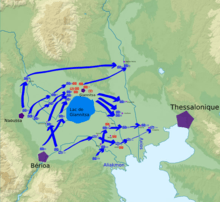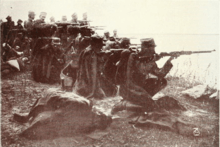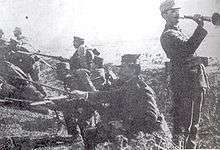Battle of Yenidje
| Battle of Yenidje | |||||||
|---|---|---|---|---|---|---|---|
| Part of First Balkan War | |||||||
 Map of the battle | |||||||
| |||||||
| Belligerents | |||||||
|
|
| ||||||
| Commanders and leaders | |||||||
| Crown Prince Constantine | Gen Hasan Tahsin Pasha | ||||||
| Units involved | |||||||
| Army of Thessaly | VIII Provisional Corps | ||||||
| Strength | |||||||
|
60.000-70.000 men, 110 guns |
ca. 25.000 men, 24-30 guns | ||||||
| Casualties and losses | |||||||
|
188 dead, 785 wounded [1] |
250+ killed during the battle 1000+ wounded during the battle 200 captured 11 field artillery pieces[2] | ||||||
The Battle of Yenidje or Yenice or Battle of Giannitsa, was a battle between the Greek Army and the Ottoman Army on October 19–20 1912, during the First Balkan War. The Greek Army defeated the Ottomans, opening the way towards Thessaloniki and capturing Yenidje (now Giannitsa/Yiannitsa).
The battle


The Ottoman army in the Greek front gathered at Yiannitsa and fortified it. The strategic location of Yiannitsa was low hills, which acted as barriers for excellent defense, while the nearby lake forced the opponents into a relatively narrow space, further enhanced with artillery units. 25,000 Turkish troops and 30 guns waited for the Greeks. The battle began on October 19 and lasted two days. The Greek military forces had to pass a bridge to the stream of Balitzas. In torrential rain, the Greek regiments had many losses and difficulties in development. By evening the Greek army completed the development of artillery and took corrective action over from Giannitsa. The raid of the Greek army was impetuous and in the morning of the 20th, the victory was a fact. The losses were heavy. The losses of the Turks were three times more. In the city there was a fire. The road to the liberation of Thessaloniki was now open.
The battle was one of the most deadly battles of the Balkan wars and perhaps the most important. It marked the liberation of the city and its inclusion in the Greek state. At the same time it paved the way for the liberation of Thessaloniki that helped shape the modern map of Greece.
After the battle, Constantine with the Army marched to Thessaloniki. Hasan Tahsin Pasha proposed terms to surrender the city, which twice were rejected by Constantine. Finally he agreed with an unconditional surrender, with the Greeks entering the city on 27th October (O.S.).